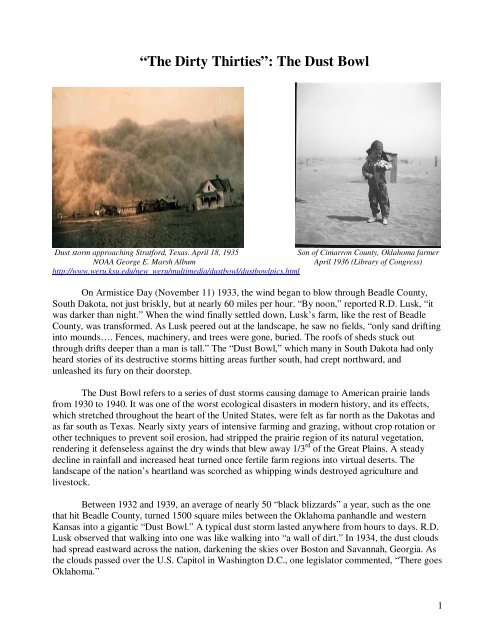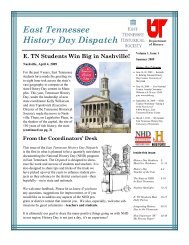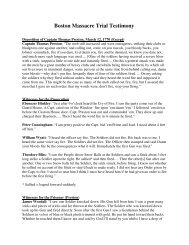“The Dirty Thirties”: The Dust Bowl - Teach American History
“The Dirty Thirties”: The Dust Bowl - Teach American History
“The Dirty Thirties”: The Dust Bowl - Teach American History
Create successful ePaper yourself
Turn your PDF publications into a flip-book with our unique Google optimized e-Paper software.
<strong>“<strong>The</strong></strong> <strong>Dirty</strong> <strong>Thirties”</strong>: <strong>The</strong> <strong>Dust</strong> <strong>Bowl</strong><br />
<strong>Dust</strong> storm approaching Stratford, Texas. April 18, 1935 Son of Cimarron County, Oklahoma farmer<br />
NOAA George E. Marsh Album April 1936 (Library of Congress)<br />
http://www.weru.ksu.edu/new_weru/multimedia/dustbowl/dustbowlpics.html<br />
On Armistice Day (November 11) 1933, the wind began to blow through Beadle County,<br />
South Dakota, not just briskly, but at nearly 60 miles per hour. “By noon,” reported R.D. Lusk, “it<br />
was darker than night.” When the wind finally settled down, Lusk’s farm, like the rest of Beadle<br />
County, was transformed. As Lusk peered out at the landscape, he saw no fields, “only sand drifting<br />
into mounds…. Fences, machinery, and trees were gone, buried. <strong>The</strong> roofs of sheds stuck out<br />
through drifts deeper than a man is tall.” <strong>The</strong> “<strong>Dust</strong> <strong>Bowl</strong>,” which many in South Dakota had only<br />
heard stories of its destructive storms hitting areas further south, had crept northward, and<br />
unleashed its fury on their doorstep.<br />
<strong>The</strong> <strong>Dust</strong> <strong>Bowl</strong> refers to a series of dust storms causing damage to <strong>American</strong> prairie lands<br />
from 1930 to 1940. It was one of the worst ecological disasters in modern history, and its effects,<br />
which stretched throughout the heart of the United States, were felt as far north as the Dakotas and<br />
as far south as Texas. Nearly sixty years of intensive farming and grazing, without crop rotation or<br />
other techniques to prevent soil erosion, had stripped the prairie region of its natural vegetation,<br />
rendering it defenseless against the dry winds that blew away 1/3 rd of the Great Plains. A steady<br />
decline in rainfall and increased heat turned once fertile farm regions into virtual deserts. <strong>The</strong><br />
landscape of the nation’s heartland was scorched as whipping winds destroyed agriculture and<br />
livestock.<br />
Between 1932 and 1939, an average of nearly 50 “black blizzards” a year, such as the one<br />
that hit Beadle County, turned 1500 square miles between the Oklahoma panhandle and western<br />
Kansas into a gigantic “<strong>Dust</strong> <strong>Bowl</strong>.” A typical dust storm lasted anywhere from hours to days. R.D.<br />
Lusk observed that walking into one was like walking into “a wall of dirt.” In 1934, the dust clouds<br />
had spread eastward across the nation, darkening the skies over Boston and Savannah, Georgia. As<br />
the clouds passed over the U.S. Capitol in Washington D.C., one legislator commented, <strong>“<strong>The</strong></strong>re goes<br />
Oklahoma.”<br />
1
Sunday, April 14, 1935 dawned clear across the plains. After weeks of dust storms that<br />
destroyed five million acres of wheat, people were grateful to see the sun high above. <strong>The</strong>y went<br />
outside to head to church, complete chores, or to picnic and sun themselves under the blue skies. By<br />
mid-afternoon, the temperatures dropped and birds began chattering nervously. Suddenly a huge<br />
black cloud appeared on the horizon, approaching fast. “Black Sunday,” often regarded as the worst<br />
storm of the <strong>Dust</strong> <strong>Bowl</strong> era, roared through Kansas, Oklahoma, and Colorado packing winds in<br />
excess of 70 miles per hour, suffocating thousands of cattle and dumping tons of topsoil and red<br />
clay on homes and streets.<br />
Those on the road had to try to beat the storm home. Some, like Ed and Ada Phillips of<br />
Boise City, and their six-year-old daughter, had to stop on their way to seek shelter in an abandoned<br />
adobe hut. <strong>The</strong>re they joined ten other people already huddled in the two-room ruin, sitting for four<br />
hours in the dark, fearing that they would be smothered. Cattle dealer Raymond Ellsaesser tells how<br />
he almost lost his wife when her car was shorted out by electricity and she decided to walk the<br />
three-quarters of a mile home. As her daughter ran ahead to get help, Ellsaesser's wife wandered off<br />
the road in the blinding dust. <strong>The</strong> moving headlights of her husband's truck, visible as he frantically<br />
drove back and forth along the road, eventually led her back to safety. Others were not so lucky.<br />
Some residents of the Great Plains, in especially Kansas and Oklahoma, succumbed to illnesses and<br />
death from dust pneumonia and the effects of malnutrition.<br />
Black Sunday was the last major dust storm of the year, and the damage it caused was not<br />
calculated for months. Coming on the heels of a stormy season, the April 14 storm hit as many<br />
others had, only harder. "<strong>The</strong> impact is like a shovelful of fine sand flung against the face," Avis D.<br />
Carlson wrote in a New Republic article. "People caught in their own yards grope for the doorstep.<br />
Cars come to a standstill, for no light in the world can penetrate that swirling murk. . . . <strong>The</strong><br />
nightmare is deepest during the storms. But on the occasional bright day and the usual gray day we<br />
cannot shake from it. We live with the dust, eat it, sleep with it, watch it strip us of possessions and<br />
the hope of possessions. It is becoming Real. <strong>The</strong> poetic uplift of spring fades into a phantom of the<br />
storied past. <strong>The</strong> nightmare is becoming life."<br />
Farmer and sons walking in the face of a dust storm.<br />
Cimarron County, Oklahoma, April 1936 (Library of Congress)<br />
2
Some 3.5 million <strong>American</strong>s living on the plains were forced to abandon their farms. Most<br />
did not travel far as they perhaps migrated to the next county. A minority, known as the<br />
“Exodusters” traveled long-distance to California in search of work. <strong>The</strong> plight of these people<br />
became widely known from author John Steinbeck’s classic novel <strong>The</strong> Grapes of Wrath (1939),<br />
which depicted the hardship of the Joad family. <strong>The</strong>se Exodusters traveled west along the historic<br />
Route 66 through the Arizona and New Mexico deserts with their belongings piled high atop rickety<br />
jalopies.<br />
Oakies stalled in California, Feb. 1937<br />
facstaff.unca.edu/.../1930's_webquest2.html<br />
More than 350,000 Oklahomans migrated to California. <strong>The</strong>se migrants were referred to as<br />
“Okies,” which later came to mean any <strong>Dust</strong> <strong>Bowl</strong>er who traveled to the West Coast. In 1937,<br />
California passed the so-called “Anti-Okie Law” stating that anyone bringing indigent persons to<br />
California from outside the state would be charged with a misdemeanor. <strong>The</strong> statute was eventually<br />
overturned in 1941 by Edwards v. California, a case stemming from the actions of Edwards, a<br />
Californian who had brought his brother-in-law from Texas and who was later convicted and sent to<br />
prison for six months.<br />
Folk Singer Woody Guthrie Novelist John Steinbeck<br />
Library of Congress Library of Congress<br />
3
<strong>The</strong> human crisis was documented by photographers, musicians, and authors of the time.<br />
Photographer Dorothea Lange made a name for herself while working as a photographer with the<br />
Farm Security Administration, capturing the impact of the storms on film. Independent artists, such<br />
as folk singer Woody Guthrie and novelist John Steinbeck, became famous for their depictions of<br />
life during the <strong>Dust</strong> <strong>Bowl</strong> of the 1930s.<br />
<strong>The</strong> federal government responded during the New Deal era by establishing the Soil<br />
Conservation Service (SCS) in 1935. <strong>The</strong>y instructed farmers to plant soil conserving grasses and<br />
legumes in place of wheat and taught them how to plow along contour lines and build terraces—<br />
techniques that slowed the runoff of rainwater and improved its absorption into the soil. Although<br />
the federal government offered little assistance to the rural farmer, plains agriculture slowly began<br />
to recover. In the fall of 1939 the rain came, finally bringing and end to a devastatingly decade-long<br />
drought.<br />
4






